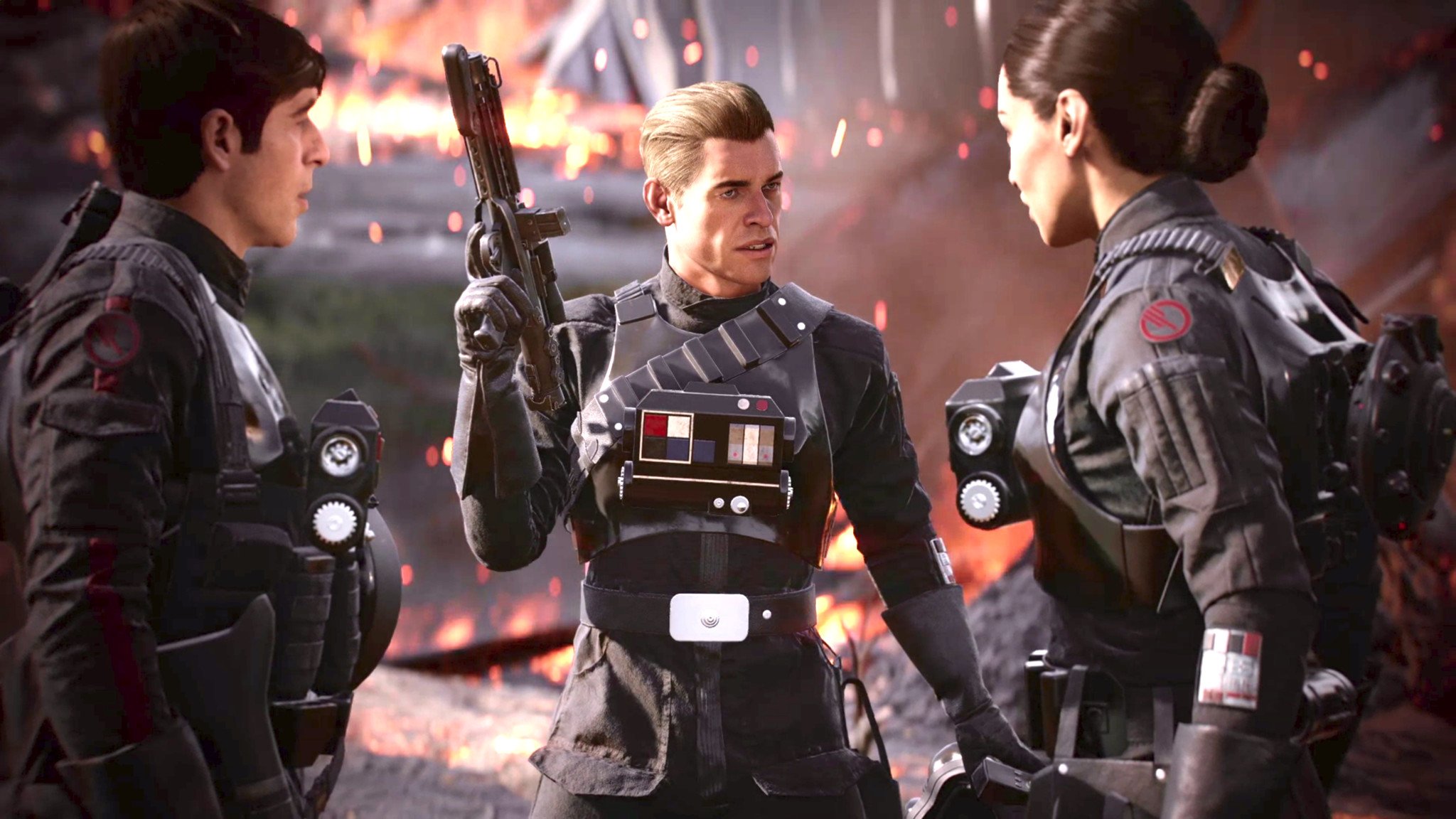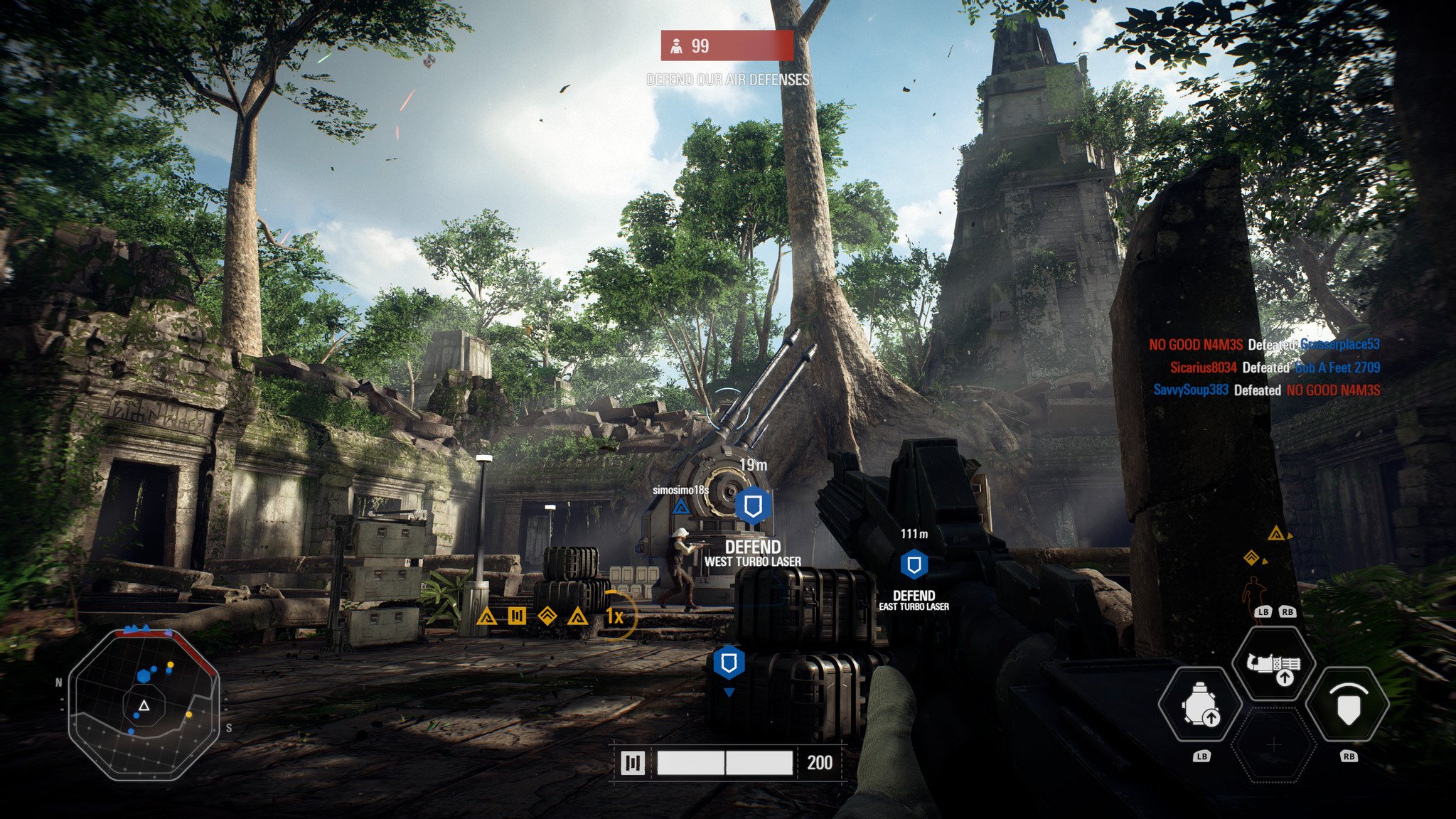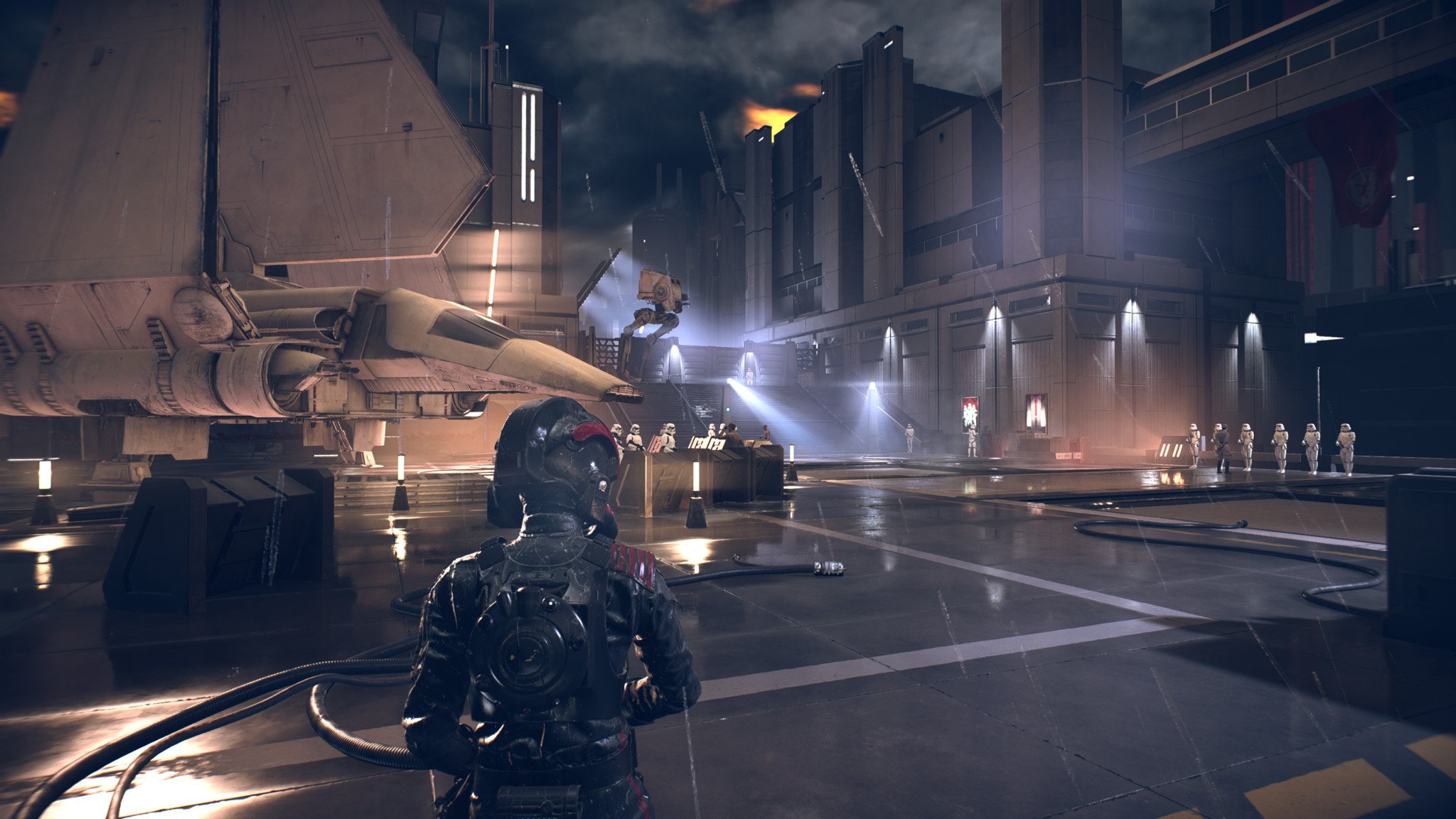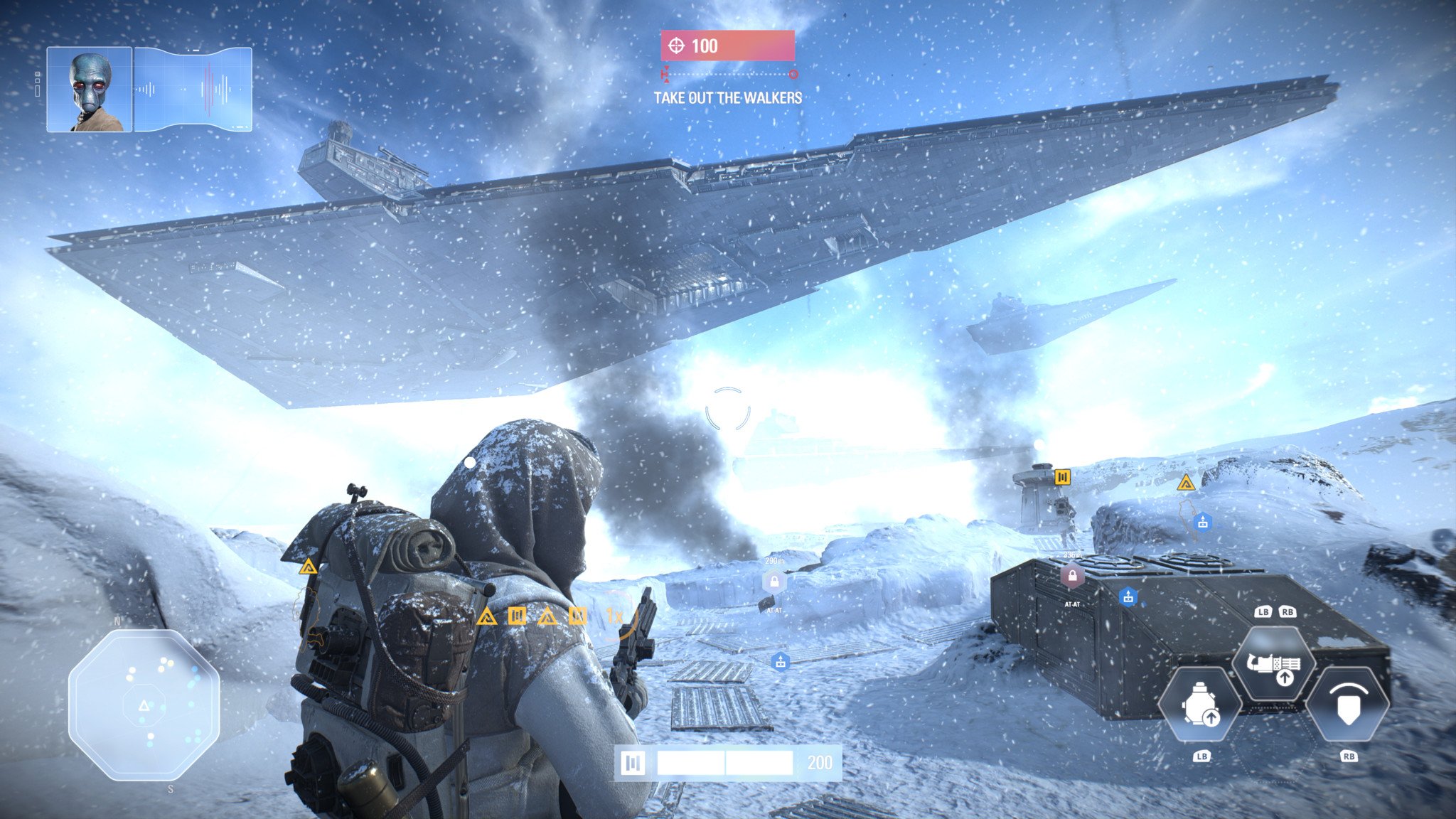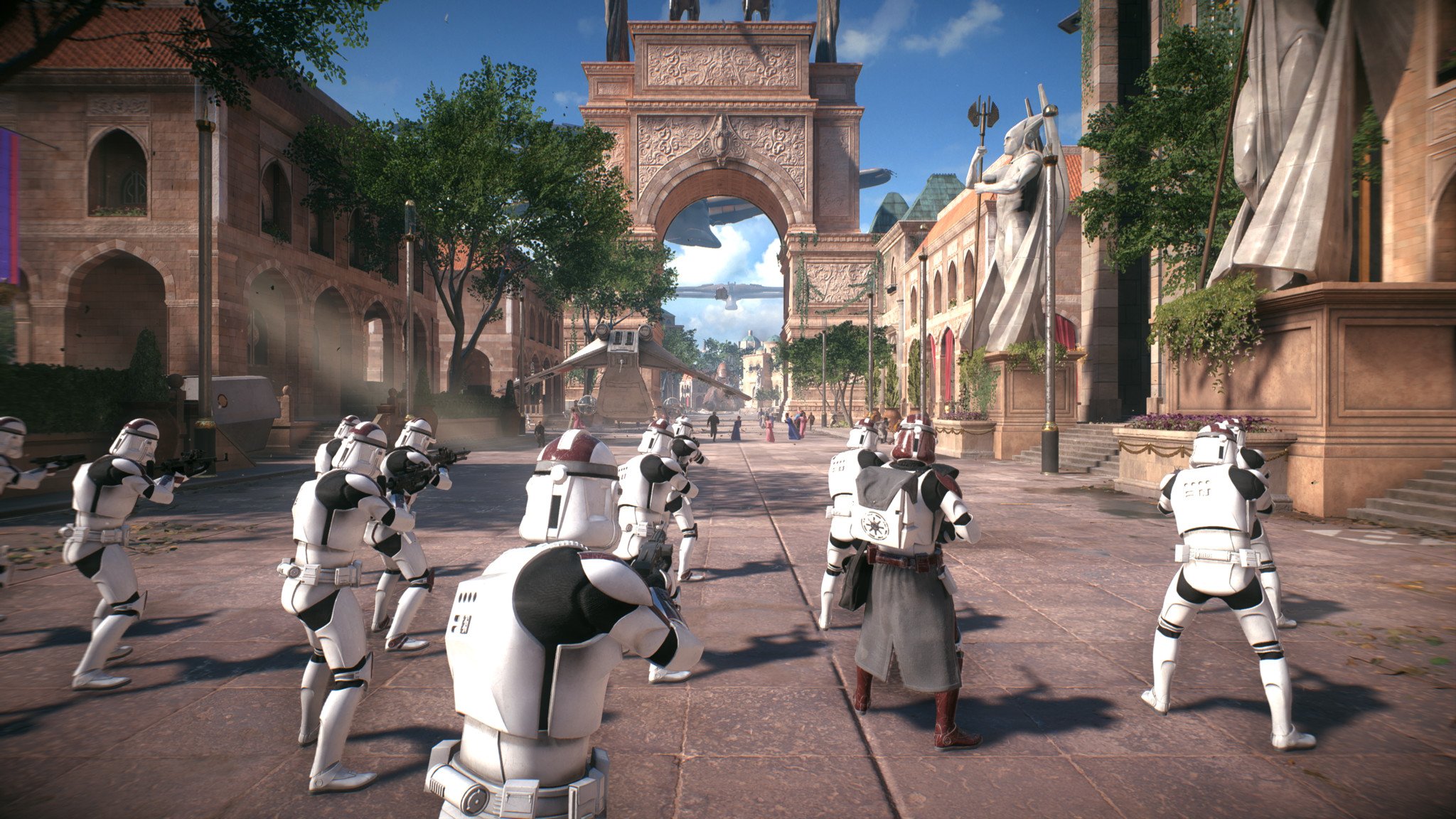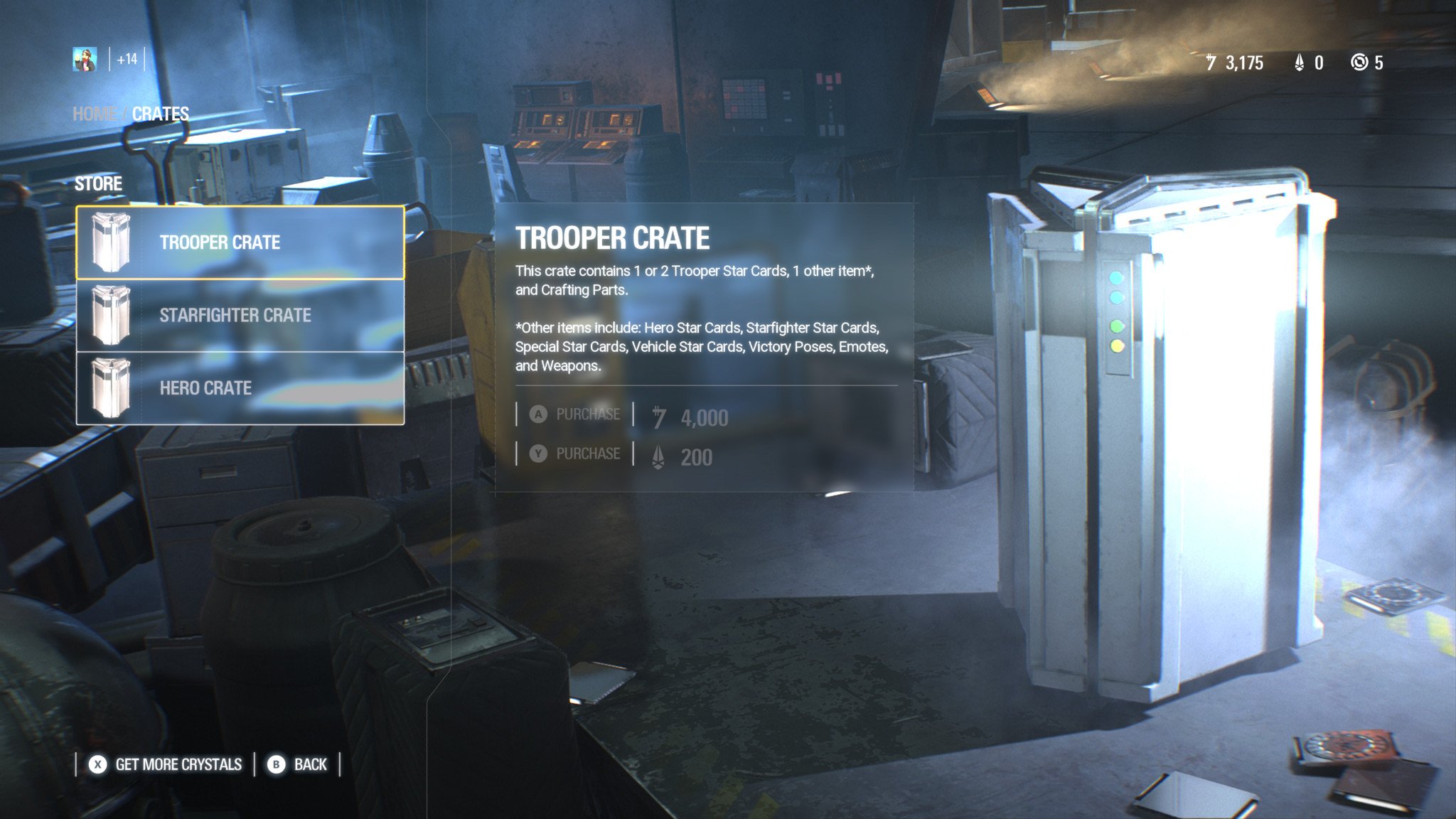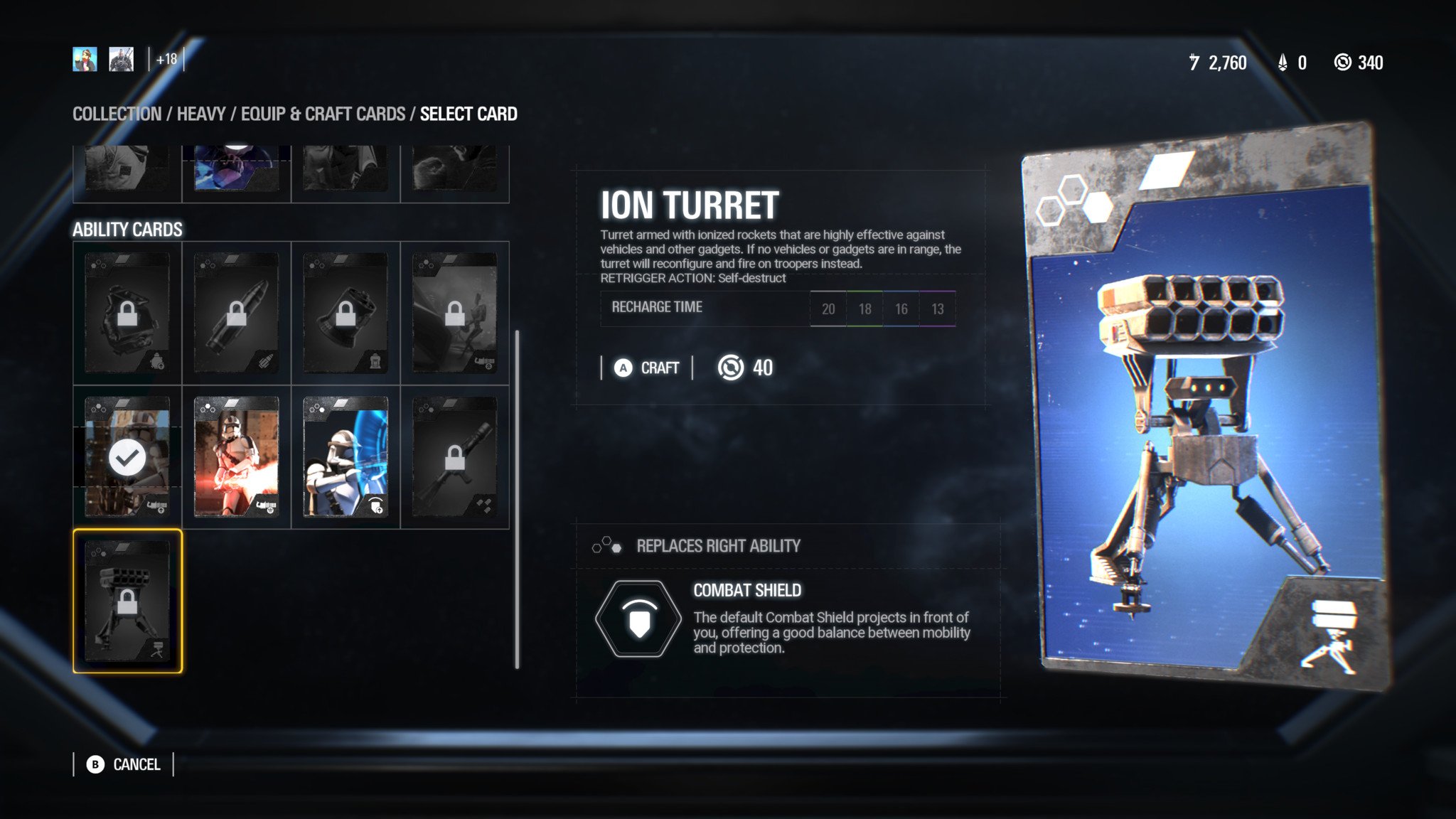
Publishers are pushing micropayments into our premium games harder than ever before, and Battlefront II might be the most egregious of the lot. The multiplayer progression is wrapped up in a system you can buy into, rewarding players with more powerful abilities depending on how much cash you splash. Or at least, it was, until EA backpedaled and shut down the premium currency following a huge, unprecedented consumer backlash.
It's a damn shame that this has to be part of the conversation because the gameplay is incredible, the visuals are on another level, and the story is fairly interesting. The tale of Battlefront II is one of incredible developers, artists, and programmers, versus the insatiable greed of its sickening monetization systems.
About this review
EA didn't provide us us early access to Battlefront II, so this is a review in progress utilizing multiple EA Access trials on Xbox One X, and a retail copy.
This review focuses on dozens of hours of play with the consumer-facing portions of the game, including arcade, multiplayer, and the game's story mode. All the images were captured on an Xbox One X at 4K, and then compressed by our system to 1080p.
Visuals, audio, and setting
On Xbox One, Battlefront II is a tale of two games. Much like its predecessor, DICE has created an incredible work of art spanning the entire library of Star Wars movie mythology. The marble palaces of Naboo, the lush forests of Kashyyyk, and the hive of villainy Tattooine itself, all rendered with an attention to detail that is simply unrivalled.
The Disney license has been put to good use, with sound effects ripped straight out of the movies for the game's various gadgets, gizmos, and high-powered blasters. The musical score rolls up and down based on the intensity of the action, much like in the theatrical versions. The final stages of a galactic assault always feel suitably climatic as a result, with gameplay to complement (more on that later).
On the Xbox One X, Star Wars Battlefront II joins the likes of Assassin's Creed Origins as the most visually stunning titles on the box. Approaching 4K resolution, with 60 frames per seconds, Battlefront II is a feast for the eyes elevated with HDR. Explosions splash blinding light on every surface, taking advantage of the extra nits provided by your HDR-capable set. Light sabers, laser blasts, and vivid environmental lighting gives Battlefront II a next-gen veneer that few games can boast. Additional details like reflective surfaces on the marble floors of Naboo and rain-swept platforms on Kamino give Battlefront II layers of depth that will distract you with their majesty.
All the latest news, reviews, and guides for Windows and Xbox diehards.
On the base Xbox One, Battlefront II pushes the box to its upper limits. The resolution on the base Xbox is rough, giving the game a blurry appearance that can actually hinder gameplay in certain situations. It might simply be the effect of going from 4K back to standard HD, but the slender models of the Clone Wars-era battle droids for example, are particularly hard to see on some maps. I think it might have been preferable for Battlefront II to reduce environmental detail to boost resolution for the sake of gameplay on the base Xbox, especially considering some of the prettier, but less "necessary" features like reflective surfaces are still present, albeit a little pixelated.
You'll still have a blast on the Xbox One S, but man, after experiencing this game on the Xbox One X, even on my cheap 4K set, I simply can't go back.
Story (minor spoilers)
The previous Battlefront title was criticized for not doing more to leverage the Star Wars IP in a story context, and Battlefront II attempts to rectify that to some degree.
Taking place directly after Return of the Jedi, Imperial Special Forces Commando Iden Versio joins the embattled Empire remnants as it attempts to fight back against the Rebel Alliance. The destruction of the second Death Star leads Versio to begin questioning the strategy and logic of her superiors, including the Emperor himself, and her father, who is an Admiral in the Imperial Navy.
Battlefront II continues the strange tradition that multiplayer-focused games need sub-par single-player campaigns.
The cutscenes and digital portrayal of Versio and the supporting cast is simply top notch, featuring some of the most impressive, photo-realistic CGI on the market. The authenticity from Battlefront II's multiplayer extends to its campaign, featuring similar environments and locations to those you'll traverse in the game's competitive modes.
The biggest problems with Battlefront II's story pertain to its writing, and gameplay, both of which fall well below the mark. The biggest draw of Battlefront II's story is its canonized lore, which Star Wars fans will relish, even if its delivery isn't so great.
The pacing of the campaign's plot, and behavior of Iden Versio and her companion, Del Meeko, are a little odd. They start off as dedicated Imperial assassins, happy to murder resistance fighters with impunity, but following a couple of events that I shan't spoil, they decide to suddenly defect. It struck me as quite odd, considering how clearly indoctrinated they are at the start of the game, regarding the Death Star's destruction with pure horror. Their reasons for quitting the Empire simply don't make sense, considering they were totally OK with a planet-killing weapon like the Death Star.
Not only is it odd how happy they are to defect, but it's odd how quickly the Rebel Alliance welcomes them in with open arms. It's lightly mentioned how crazy the Rebels are for accepting two notorious Imperial spies and saboteurs into their ranks, as if that were enough for it to make sense. It just seems forced and silly.
The characters themselves are quite cool, and it's fun seeing Star Wars heroes in new settings bridging gaps between Return of the Jedi and The Force Awakens, but it all comes off as a little rushed and haphazard. The gameplay might have saved it, but the A.I. is staggeringly stupid, and the levels amount to dull shooting galleries most of the time, playing like multiplayer levels, without multiplayer enemies.
Battlefront II continues the strange tradition that multiplayer-focused games need sub-par single-player campaigns, sadly. That said, Star Wars fans will still find enjoyment in its funny scenes, references, and more pivotal moments. Some of its finer plot implications are particularly interesting, especially towards the end.
Multiplayer
Make no mistake, Star Wars Battlefront II represents some of the best and most explosive shooter gameplay on Xbox One right now, when you disregard the lens of micropayment-encouraging progression that strangles it.
Slicing up Yoda as Kylo Ren felt somehow... wrong. pic.twitter.com/6hq8HmHqUo— Jez☕ (@JezCorden) November 10, 2017
Battlefront II comes with various gameplay types, including close quarters combat, objective-based scenarios, and all-out Hero warfare, but you'll probably spend most of your time either in its 20 vs. 20 Galactic Assault mode, or 12 vs. 12 Starfighter Assault mode. Both of these come with attack/defend type gameplay across Star Wars Battlefront II's huge amount of locations, tasking players to either assault or defend various objectives as your team progresses to victory, or wastes your enemy's respawn tickets.
Initially, you choose one of four classes. A defensive "heavy," a run n' gun "assault" class, a sniper-style "specialist," and a supportive "officer" class. I have spent most of my time playing the heavy class, which comes with light machine gun-style laser cannons and various defensive tools to help push forward your team's line.
Battlefront II follows its predecessors, allowing players to elect to use either first or third person views. It ditches the arcade-style power up tokens found in the previous game, allowing you to purchase upgrades mid-match based on your performance in battle. This makes battles feel a little more immersive than the previous game, where hovering random power-up tokens didn't really fit the game's aesthetic.
Make no mistake, Star Wars Battlefront II represents some of the best and most explosive shooter gameplay on Xbox One right now.
You get points for assisting with kills, making kills, playing the objectives, dealing damage, and even for dying. The more points you get, the better power ups you can buy on the respawn screen. Some of these include tank-like vehicles, special classes like a rocket trooper or Wookiee with boosted health and damage, and of course, hero classes represented by characters from the movies. The way the points system is handled builds up well in Galactic and Starfighter Assault modes, meaning more epic battles and situations occur dynamically as the matches progress, leading to climatic moments and desperate fights to the death.
Hero classes are far more powerful than standard soldiers, with more health and damage, but they never feel overpowered. Only a few can be on the field at any one time. A concerted effort between 2-3 players can quite easily dispatch any careless hero, while a skilled player can skirmish in and out of fights, knowing when best to take a step back to recover. I was able to rack up a 20-player killstreak with Yoda during EA's early access period, it simply feels amazing to be in the driver's seat.
Yoda is hilarious to play as. Slice slice slice slice slice. pic.twitter.com/az9pP0lPht— Jez☕ (@JezCorden) November 12, 2017
While hero classes have a distinct advantage in combat, regular classes all their own tools to get ahead. The heavy can activate sentry mode, which grants increased damage output for decreased mobility. Using a gattling laser to mow down enemies feels incredible, and you can quite quickly dispatch hero classes who aren't paying proper attention in this mode as well. Other classes have similar abilities on varying cool downs, including a run n' gun powerful shotgun mode as assault, healing abilities as an officer, and detection abilities as a sniper.
The class structure extends to the game's space combat mode, Starfighter Assault too, allowing you to jump behind the wheel of legendary ships like the Millennium Falcon and Boba Fett's Slave I. Enlisting racing aficionados Criterion was the right move for this mode, as the vehicular combat feels far superior to the previous game. While the controls are familiar, it ditches some of the simplicity.
The skills feel balanced over all (at least at their base level), although I haven't had time to play around with all of them. It's hard to fault Battlefront II on its multiplayer gameplay alone, it's simply incredible and authentic, encouraging team and objective play with its score system, and rewarding the best players with access to the franchise's most beloved characters. The issues arise with its intentionally convoluted progression system.
The micropayment fiasco
More and more publishers are chasing micropayment models, and Battlefront II follows this trend aggressively. Horribly so.
Battlefront II's entire progression system revolves around boxes of random star cards that grant you classes, characters, and vehicles with passive bonuses and new skills. But to confuse matters more, Battlefront II also has separate levelling systems that attempt to "gate" progression, to prevent players with more cash from simply buying their way to an advantage. It reduces the "pay-to-win" nature of the system to some degree. EA removed the game's premium currency following a huge backlash= but admitted it will be reinstated later.
To progress your preferred class, you need to obtain more cards for that class. To obtain more cards, you have to rely on the luck of the draw. Trooper crates for the base classes cost 4,000 credits, and you obtain about 200 to 400 per match. It can take well over an hour to afford a new crate, and most of the time, you probably won't get the cards you want.
As my challenges dried up, progression with my heavy class slowed to an abysmal, unrewarding grind – with no end in sight, due to the sheer randomness of the loot crates.
The system is softened somewhat with crafting parts, which spawn out of non-paid crates in relative abundance. In about four hours of play, I managed to get enough crafting parts to simply buy all the base cards I wanted for my Heavy class without spending real money on extra cards. And the credit flow can be expedited with challenges, which grant extra rewards for performing certain feats, such as getting headshots or high kill counts. Initially, this gives you a decent boost of credits, particularly if you complete the campaign. However, as my challenges dried up, progression with my heavy class slowed to an abysmal, unrewarding grind – with no end in sight, due to the sheer randomness of the loot crates. At this point I realized just how aggressive these systems were, even if my initial feelings about them made me apologetic. It destroys the progression gameplay.
The ability cards themselves can be levelled up, and some of them provide significant bonuses for doing so, usually in the form of reduced cool down times, bigger blast ranges, and health returned. Some of these upgrades include flat damage bonuses, too, and for those players who are buying crates, they will quite easily rack up a non-trivial gameplay advantage as a result, creating a digital caste system between players with disposable income and those without.
The upgrades themselves are also gated behind a global rank, which increases simply by playing, similarly to Battlefield games. I wasn't able to spend my crafting parts to upgrade my Heavy's star cards to level three (out of five), because I haven't played enough to obtain global rank 15 yet.
You can obtain higher level cards directly out of paid loot crates, circumventing the ranking system. Once again, this provides gamers buying additional crates with real money an advantage.
However, you can obtain higher level cards directly out of paid loot crates, circumventing the ranking system. Once again, this provides an advantage to gamers buying additional crates with real money.
Originally, purchasing additional hero characters such as Darth Vader cost anywhere up to 60,000 credits. Considering you only get around 400 credits at most per match, this was far, far too high, especially as the boost from challenges dried up. Following a sizeable backlash, primarily on Reddit, EA responded by reducing the cost of heroes by 75 percent, down to 15,000 at most. This feels like a far better figure, considering how fast you can acquire credits by completing challenges. Players that save their credits by buying crates with real money will be able to obtain heroes far faster, again, but this is nowhere near as prohibitive and skewed as it was previously.
Ultimately, Battlefront II's progression system is poisoned with issues stemming from the desire to get people to buy crates with real money. It hinders natural FPS progression gameplay by asking players to trade money for power, and it leaves a sour taste on the tongue. Whether or not the funds generated from these systems will materialize in a high-value live service remains to be seen, but at least for now, it feels like it's designed to abuse and manipulate gamers rather than offer a good time.
Conclusion
If you were looking to get into Battlefront II for the multiplayer experience, at its core, Battlefront II is absolutely tremendous, flawless, and beautiful. It's when your attention turns to progression that things start to get murky.
EA can make all the excuses it wants, but it's a fact that it has abused the good will of its customers, and the fans of Star Wars.
By offering players the ability to progress with real money instead of via their earned credits, the balance between a paying player and a non-paying player is skewed in favor of the richer player, which is depressing given the upfront cost of this game. It's simply sickening in a competitive multiplayer game, exasperated by the fact that this is a widely beloved franchise, often enjoyed by youngsters. EA can make all the excuses it wants, but it's a fact that it has abused the good will of its customers, and the fans of Star Wars.
Pros:
- Stunning, authentic Star Wars visuals.
- Tight multiplayer gameplay.
- Epic space combat.
Cons:
- Stale story campaign.
- Unclear whether pay-to-win mechanics will return.
- Progression designed to maximize premium currency purchases.
Games are getting more expensive to make than ever, and I do like the idea of Battlefront II having a live service, with free content drops to keep the game alive and active. I appreciate that these things cost money, and that developers should be compensated heavily for their time and talent – but defining these systems is a balancing act.
If you buy this game, you'll have an insane amount of fun, whether you buy loot crates or not, but after spending dozens of hours playing my Heavy, it's apparent to me that EA has designed progression to become a struggle for those who don't want to buy crates. If there's a line to cross, EA didn't just step over it, they blew it up with the Death Star.
All the downsides combined, it's just hard to recommend this game in its current form, which is painful to write as a fan of Star Wars, DICE, and honestly, Battlefront II.

Jez Corden is the Executive Editor at Windows Central, focusing primarily on all things Xbox and gaming. Jez is known for breaking exclusive news and analysis as relates to the Microsoft ecosystem while being powered by tea. Follow on Twitter (X) and tune in to the XB2 Podcast, all about, you guessed it, Xbox!
